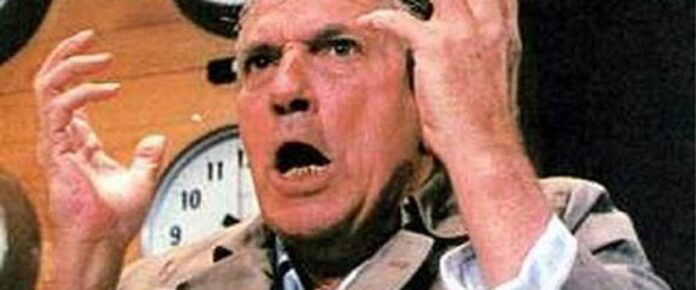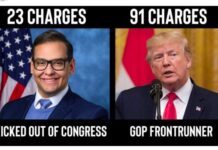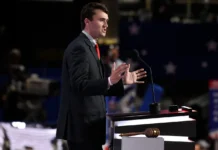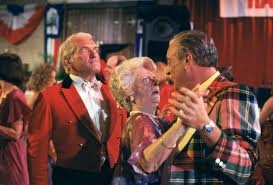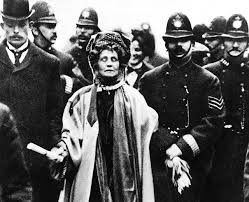When Ted Turner introduced 24-hour cable news on CNN in 1980, he reshaped the news journalism business in ways that made it less comprehensible to average viewers.
News coverage became less focused on local news and expanded on stories that would attract and maintain a national audience. This meant the news stories became broader and less specific to make them more palatable, but often less understandable, to a wide audience tuning in at different time zones across the U.S.
The only focus on news was when there was a national tragedy: an assassination, an economic crash, an election, a terrorist attack, and increasingly, more political activity in Congress, the courts, and the executive branch.
This posed a challenge to new broadcast executives: How can they keep viewers tuned for more than a few hours daily? Could they do it through charismatic news personalities and different formats while keeping production, talent costs, and risk levels down?
Cable News Is Still Looking For A Profitable Format
Since 1980, cable news has tried many formats to keep and attract an audience. However, today we see that the major cable networks (CNN, MSNBC, and FOX) have still not found a viable format, aside from primarily relying on pushing a political perspective that will wax and wane as presidential administrations change.
This has resulted in significant changes at MSNBC and CNN, but the changes have not solved the problem.
The problem is that these national cable news formats overlook the essence of journalism:
- Presenting the news
- Providing the needed information that puts the news in perspective
- Interpreting the news
This is why viewers watching the news are often confused. Unlike the traditional, tried-and-proven newspaper format, cable news shows usually do not have a lead story, followed by lesser news that is still pertinent to the audience. Or, if they do, the network’s focus is on that lead story. Everything else that happens in the country that affects the national audience is neglected and never covered.
Viewers watching national cable networks are confused and fed news stories simply because the network correspondent has already prepared the story for the day. This forces the network to use the correspondent’s video report even if it is unimportant or has already been covered by the same network many times.
This is good for the network since it keeps costs down (they already have the video), but it does not benefit viewers and makes for repetitive broadcasts.
Cable Viewers Should Get Smart
However, cable viewers should not despair. Good citizens must be informed, and there are great choices for getting better news reports.
Since the networks are loath to change their formats or fire or re-assign their on-air newsreaders, viewers can get more and better news by following these suggestions.
First, watching or listening to the news for over two hours daily wastes time.
You will not be better informed. Instead, you will hear the same news stories repeated for a few days, watch panel discussions with forgettable participants, and watch news announcers who either read Teleprompters or lack the expertise to conduct an interview.
Cable news has also been hit by low-quality, less professional competition from social media, podcasters, right-wing radio haters, and even TikTok. Navigating through this social media/podcast swamp is Herculean since it changes daily, and the turnover is too high.
That’s why it pays to watch the best-informed news casters with solid professional news staff who can explain issues as they affect average Americans. This will save time and reduce anxiety about watching the news.
Here are some modest suggestions to optimize your time by watching quality cable news and radio for less than two hours daily. (Note: This summary excludes podcasts and social media since their quality is often uneven and constantly changing.)
General Cable News
MSNBC
On MSNBC, the most professional anchors are Ali Velshi and Lawrence O’Donnell on political and international news, and Stephanie Ruhl on economic issues. MSNBC’s early morning and late-evening shows (Morning Joe and Lawrence O’Donnell) are much better than others in the network’s programming day. Morning Joe’s success is tied to its talented round table participants, and serious journalism veterans (Willie Geist, Mike Barnicle, and  Jonathan Lemire), who ask pertinent questions and who, along with Mika Brzezinski, keep the long-winded Joe Scarborough in check. The show is unusual because it includes news about cultural events (Broadway shows and theater) and sports. This variety enhances the coverage and makes it more interesting.
Jonathan Lemire), who ask pertinent questions and who, along with Mika Brzezinski, keep the long-winded Joe Scarborough in check. The show is unusual because it includes news about cultural events (Broadway shows and theater) and sports. This variety enhances the coverage and makes it more interesting.
While popular, Rachel Maddow (salary: $25 million annually), who developed a storytelling or “talk television essay format for news, “tries to be informative but quickly becomes repetitive. Her assignment of doing a multi-hour show is too much to ask. Tenured professors cannot deliver a coherent lecture and remain fresh on a topic they have studied for years.
Many other MSNBC news readers (Jen Psaki, Nicole Wallace, Katie Tur, and Ari Melber) host shows from 12:00 pm EST to 6:00 p.m. EST that repeat the news or offer endless analysis and conjecture, often to bored guest experts who have answered the same questions many times over. One obnoxious practice is when Nicole Wallace (salary: about $1.5 million annually) asks 500-word questions of guests who have to look interested while she blathers on her monologue. Incredibly, her producers don’t provide feedback to her and others that their questions are inane and wordy.
Ari Melber also digresses into rap lyrics in the middle of his new reading, which leaves many viewers wondering what he is talking about or how the lyrics are relevant to the news. Maybe the producers are too unprofessional to notice, or else they are intimidated by the overpaid news readers. This is a reason that accounts for MSNBC’s recent programming and on-air personnel changes.
Seeing its viewership decline since Kamala Harris lost the presidential election, MSNBS is trying to regain viewers, but it is still using the same set pieces. For instance, it launched a new weekday evening program in May 2025, “The Weeknight,” featuring Symone Sanders Townsend, Michael Steele, and Alicia Menendez. But again, this is just the same old three people sitting around a table discussing the day’s news. Adding a guest or two does not change anything. This show will not go anywhere.
Similarly, MSNBC decided to give the forgettable Jen Psaki a new show. After a few weeks, Psaki’s ratings started falling, which is no surprise. Psaki was never a news reporter, and she has no TV presence. If she had great contacts in the Biden White House, they are nowhere to be seen now. Psaki will never break a news story, so the network honchos can start writing this show off. Maybe the MSNBC execs should look at their video library to see powerful old shows like “Point-Counterpoint,” Mike Wallace interviews, BBC John Sakur interviews (see below), William Buckley’s “Firing Line,” Helen Thomas’ questions to politicians, and the “See It Now” series with Edward R. Morrow.
These shows were influential journalism from another time. The news people did not have to deal with paid liars and an army of Republican sociopaths. But these interviewers had something that is not present today in the politically correct, wimpified, vapid news business. WWII and the Great Depression shaped these men, and they covered the last generation of great American politicians the nation has ever produced: FDR, Eisenhower, Truman, John Kennedy, and cabinet members Cordell Hull, George Marshall, Dean Acheson, John Foster Dulles, and Dean Rusk.
Today’s cable news readers have never met such powerful, intellectual politicians and judges, so they never trained or were exposed to the major leagues of American leadership. That’s why it is almost impossible to find on-air talent worth the salaries and responsibilities the cable news execs expect these people to fill. If you add social media, AI, disinformation campaigns, and propaganda, the cable executives will never be able to stop their viewership slide.
CNN
CNN does not have a general news show like MSNBC’s Morning Joe. Instead, it relies on a general news presentation that mixes national and international news. CNN’s website says, “CNN News Central is the core hub of the network’s best-in-class newsgathering operation during the day, bringing stories to viewers in real-time while offering perspective and context to key issues.” This may be true, but it is not designed for people who value their time. That’s why the news announcers always plead for viewers to “stay tuned for breaking news” even when there is nothing new to report. This is an old, cheap trick to retain viewers for the next time slot.
CNN also has some tired news readers. At the top of this list is Wolf Blitzer (salary: about $15 million annually), who is on auto-pilot during his show as he reads from the teleprompter when conducting interviews, or else goes into memorized phrases (“Thanks for that excellent reporting,” “That’s very interesting and informative,” “May his memory be a blessing,” and “Stay tuned for more breaking news.”)
Watch Local News
Local news broadcasts from the networks (CNN, NBC, FOX) have remained with the old broadcast news formats, and this works best in their time slots, which are often 30- to 60-minute long. These broadcasts have a good mix of national and local news. Local NPR radio stations also have a great mix of regional and national news and are organized into 30—and 60-minute blocks.
Financial News
The best choices for general economic news (excluding stock and trading tips) are Bloomberg Radio and cable TV. Bloomberg has quality financial experts and top producers, and its guests are all qualified and have been identified with national investment and economic firms. Bloomberg is not only for financial experts. Average Americans who want a better education about economic news should not be intimidated by the quality discussions and the jargon. Over time, they will get an excellent education about the markets and financial news from professionals who connect the dots between a Trump policy and how it will affect their pocketbooks and the economy.
CNBC is also good for traders and active investors who get many investing opinions from guests. However, these guests’ experience and educational quality vary widely, as do their recommendations. It is worth noting that the turnover rate among active day traders is about 80% per year, so average people who want to quit their jobs to become day traders or invest in crypto (the biggest Ponzi scheme of the 20th Century) should reconsider their actions.
International News
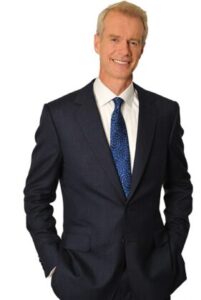
By far, the best international reporting is done by the BBC. This is because the British have been a global power since the 1600s, so they know about politics and economics in the Middle East, Asia, Africa, and all of their former colonies. The BBC is state-run, so it has a long history and tradition. It may be cultural, but its reporters do not accept evasive or fabricated answers from interviewers. American journalists should listen to the BBC show “Hard Talk” to hear its host, Stephen Sackur, conduct an actual interview that holds the interviewee accountable for what they say.
Instead, too many American journalists have become either deaf to the non-answers or lies that most Republican politicians provide. Yet, they get away with lying to the American people, even if they fool the interviewer. This is why lying has become so common in political interviews. It is also a reason why journalists are held in low esteem. After all, how serious can the public consider you if politicians can lie to your face, and you look at your shoes? Don’t become a reporter if you are non-judgmental, uninformed, and timid.
CNN’s Farid Zacharia and Christiane Amanpour also have timely foreign policy news shows.
Podcasters, Social Media
This is an ever-changing scene, but most podcasts offer a political perspective and are not news shows. News shows require a large staff and budget, so that excludes podcasters.
